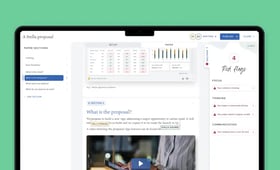Key takeaways
- Well-structured board packs transform board conversations, turning meetings from routine updates into strategic discussions.
- Balanced packs close blind spots by combining operational detail, external context, and options to support better decisions.
- Modern board portals save time and reduce friction, streamlining preparation, distribution, and collaboration anywhere.
- Clear, focused reporting turns insight into action, highlighting the “so what?” to speed informed decision-making.
- Templates, AI tools, and workflows scale governance best practices, keeping board reporting consistent, high-quality, and compliant.
What is a board pack, and why does it matter?
The board pack is the chief stimulus for the conversation in the boardroom. So, if you feel your board conversation isn’t as focused or productive as it could be, the problem might lie with your board papers.
Board pack definition and core components
Board packs contain the documents, reports, and information that boards use to prepare for their upcoming board meetings. It tells them everything they need to know about the organization’s health. It also typically provides details on any updates since the last meeting.
The role of board packs in corporate governance
A good board pack is the key to an organization’s healthy governance. It serves a central role in keeping board members informed and engaged, and keeping executive teams accountable.
Digital vs. printed board packs: modern best practices
Historically, organizations used printed board packs. In recent years, however, organizations are increasingly looking to make the most of the benefits of board portals. Their main reasons are to improve the security of sensitive information and enhance collaboration between board members.
What are the 6 essential elements of effective board pack creation?
When reviewing the quality of a pack, we consider six key areas:
1. Scope: Eliminate board pack gaps
A well-constructed board pack should give directors the complete picture they need to steer and supervise effectively. Too often, however, scope is narrowed, leaving gaps that weaken decision-making. Three common gaps stand out:
Balance backward-looking financials with forward strategy
Board packs can become overloaded with historic financial data. While financial reporting is an important part of any board pack, directors also need forward-looking insights that connect performance to future strategy. Without this balance, the pack will anchor the board’s conversations in the past rather than helping shape what comes next.
Include external developments and peer innovation updates
An effective board pack looks beyond the walls of the organization. Updates on market trends, competitor moves, and peer innovations give directors the external context they need to challenge assumptions and anticipate change. Without this, the board risks operating in a vacuum.
Present multiple options vs. single preferred solutions
Individual papers often present only the author’s preferred recommendation. Stronger papers surface alternative options, weighing their risks and benefits. This allows directors to analyze trade-offs and make more robust decisions, rather than being channeled down a single path.
2. Accessibility: Ensuring that board members can access information when needed
Directors don't have much free time, so access to board materials must be seamless. The board's ability to prepare and contribute effectively is compromised if information is hard to find, delayed, or available only in limited formats. Accessibility is about convenience as much as it is about enabling informed, timely decision-making.
Board portal benefits for instant access and updates
Modern board portals improve how directors receive information. Instead of waiting for bulky PDFs or paper packs, directors can log in the moment a pack is published and always see the latest version if updates are made. This way, the board is always working from a single, current source of truth.
Offline access and mobile-friendly board materials
Effective board portals provide mobile and offline access, so directors can read and annotate materials whenever it suits them. This flexibility means preparation doesn't depend on connectivity, allowing board members to stay engaged wherever they are.
Timing: When to distribute board packs for optimal preparation
Accessibility isn’t only about technology; it’s also about timing. Packs should be distributed early enough to give directors the time they need to read, reflect, and prepare questions. Ideally, directors should get their board packs at least one week in advance.
Our research, however, shows that 55% receive them fewer than five days before meetings. Late distribution leads to low engagement and can reduce board discussions to surface-level exchanges instead of strategic debate.
3. Style: Writing board papers that are easy to read and digest
Board papers are only valuable if directors can quickly absorb and act on them. Dense, wordy documents risk obscuring the real issues and wasting valuable boardroom time.
The 5-page maximum rule for board papers
The average board pack is now 226 pages long, up 30% since 2019. Worryingly, only 40% of board packs are below the 100-page mark.
As a rule of thumb, board papers should be no longer than five pages. Keeping things brief forces authors to prioritize what matters, strip out unnecessary detail, and focus on the insight directors need to govern well.
Logical structure that highlights "so what?" messages
The best board papers have a logical and visible structure that clearly outlines the “so what?” and the action proposed by management.
Frameworks like the QDI Principle (Question-Driven Insight) help authors present information in a way that surfaces the important issues and links evidence to conclusions. They help clarify what action the board is being asked to take. In practice, this means every paper highlights the “so what?” of the issue and the decision required from directors.
Read how the QDI Principle can help you write better board packs.
George Bernard Shaw's communication principle applied to boards
George Bernard Shaw observed that “the single biggest problem with communication is the illusion that it has taken place.” Too many board papers present information but fail to communicate meaning. Applying this principle means writing with the reader in mind. This makes every paper informative, clear, purposeful, and actionable.
4. Efficiency: Streamlining board pack preparation
Board members have limited time to read papers; management has limited time to prepare papers. A clear brief, a consistent format, and templates with prompts and guidance for the writer make the reporting process more efficient. The result is a paper that answers the questions on the board’s mind and helps the writer focus on what really matters.
Creating clear briefs and consistent formats
Efficiency begins before the first word is written. Clear briefs set out the question being asked, the decision required, and the context the board needs. When combined with consistent formats across all papers, this reduces ambiguity for writers. It allows directors to navigate the pack quickly without adjusting to different styles each time.
Templates with prompts and guidance for writers
Good templates don’t just provide a layout; they actively guide authors. Prompts encourage writers to consider alternative options, highlight risks, and focus on outcomes rather than unnecessary detail. This saves time while making sure the essentials aren’t overlooked.
Board Intelligence templates, grounded in 20 years of board reporting research, are effective frameworks for the most frequently written board reports. They contain:
- Prompts to see that your report covers the questions on the minds of your readers
- Templates appropriate for the subject matter being covered by the report and the type of discussion it's supporting
Scaling best practices across large organizations
The bigger your organization, the harder it is to maintain quality and consistency across multiple authors. Embedding best practices through shared templates, training, and digital tools means that whether a paper comes from finance, operations, or HR, it reflects the same high standards. This helps the board engage with issues rather than formats.
Tip: Download the “Best-in-Class Board Pack Checklist” to assess how your board pack stacks up.
5. Expertise: Incorporating subject matter expert contributions
Today's corporate board tables are looking for people with deep expertise in:
- Digital technology
- Cyber fraud
- Social media
- International market entry
- Corporate governance
- Scientific knowledge for science-based companies
- The board’s role in sustainability and other specialized fields
These experts bring important domain knowledge, and their insightful contributions are key to an effective board pack.
Presenting complex information for non-expert board members
The people who create your board pack must know how to present information as clearly as possible so that board members, who are not in the business day-to-day, are able to easily digest the papers.
Planning deadlines for expert review and input
Plan ahead when setting deadlines for paper submissions. This way, there is enough time to review the pack’s content and distribute it to board members before the meeting.
Balancing technical detail with strategic insight
Report writers often struggle to strike the right balance. Too much operational or technical detail and the board risks being overwhelmed in the weeds; too little and directors can’t exercise proper oversight.
Key approaches are:
- Start with the “why” before the “what”
- Prioritize the details
- Use plain, purposeful language
- Connect to decisions
- Visualize the essentials
6. Impact: Ensuring that board packs drive productive conversations
The ultimate test of a board pack isn’t how polished it looks, but the quality of the discussion it sparks. A strong pack helps directors focus on the issues that matter most, challenge constructively, and make well-informed decisions. A weak pack leads to wasted time, superficial debate, and missed opportunities.
Measuring board pack effectiveness through meeting quality
One way to judge board effectiveness is by looking at the meeting itself:
- Are conversations strategic and forward-looking?
- Are directors able to focus on trade-offs, risks, and opportunities rather than clarifying basic facts?
If the board consistently has conversations that balance oversight with foresight, then the pack has done its job.
Board Intelligence emphasizes this link between papers and conversations through its Six Conversations framework, which helps boards assess whether the right issues are coming to the table.
Signs your board pack needs improvement
Not all packs hit the mark. Warning signs include:
- Meetings that run out of time without resolving key issues
- Directors asking for information that should already have been provided
- Debates that circle around detail instead of landing decisions
These symptoms suggest that the pack isn’t surfacing the right insights or framing the “so what?” clearly enough.
Regularly reviewing your board pack against these outcomes and using board reporting software to structure content more effectively can transform its impact. Every meeting becomes time well spent.
Connecting board papers to decision-making efficiency
The speed and quality of board decision-making are directly shaped by the papers directors receive. Packs that set out the decision required, the rationale, and the alternatives allow directors to move quickly from discussion to resolution. When this clarity is missing, time is wasted on understanding the basics and revisiting issues across multiple meetings.
Board pack templates and best practice examples
Board packs are most effective when they follow consistent, well-designed templates that provide clarity, focus, and accessibility. While each organization has unique needs, certain structures and components are widely recognized as best practice.
Standard board pack structure and components
A typical board pack includes several core sections that guide directors from context to decision:
- Agenda: A clear outline of topics and timings.
- Executive summary: A high-level overview of key issues, recommendations, and actions needed.
- Financial reports: Performance metrics and analysis, ideally paired with the right context.
- Operational updates: Summaries from key departments, highlighting progress against strategic goals.
- Risk and compliance reports: Key risks, mitigations, and regulatory updates.
- Supporting papers: Detailed reports on specific projects, initiatives, or decisions.
Templates that integrate these components consistently make packs easier to digest, improve preparation, and reduce time spent searching for information. Board Intelligence’s portal includes ready-made templates and embedded prompts that help management produce structured, high-quality papers.
Industry-specific board pack variations
Not all boards have the same priorities. While the structure above is a solid foundation, sector-specific variations are often necessary:
- Nonprofits may emphasize fundraising, donor metrics, and social impact reporting.
- Financial services boards often require detailed regulatory updates, capital adequacy reports, and risk dashboards.
- Technology companies may focus on innovation pipelines, product metrics, and market trends.
Using adaptable templates allows boards to maintain consistency while reflecting industry-specific needs, so directors can focus on what matters most.
Executive summary and dashboard design
The executive summary is arguably the most important part of the package. It should distil complex information into concise insights, highlighting key decisions, risks, and opportunities. Dashboards and visual summaries complement this, helping directors absorb quantitative and qualitative data at a glance.
- Use clear headings and short sections to guide the reader.
- Include charts or visual KPIs to summarize trends and performance.
- Focus on decision-oriented insights rather than raw data.
Board Intelligence provides tools for creating executive summaries and dashboards that automatically pull in key metrics and trends. This creates consistency and saves preparation time while giving directors a clear, actionable overview.
Find out how to write an executive summary for your board. While you’re there, download a free template that gives you everything you need to put the secret CQC (context, questions, conclusion) formula into practice.
Technology solutions for board pack creation
Creating effective board packs is no longer just about formatting documents. Technology now plays a central role in improving efficiency, accessibility, and insight. Modern solutions help boards prepare, distribute, and review papers faster, while giving directors the context they need to make informed decisions.
Board portal selection guide
A secure, intuitive board portal is the foundation for efficient pack creation and distribution. When selecting a portal, consider:
- Security and compliance: Encryption, access controls, and regulatory standards such as ISO 27001 or GDPR.
- Ease of use: A user-friendly interface provides directors and administrators immediate access to what they’re looking for.
- Version control and updates: Directors should always see the latest information without confusion.
Board Intelligence’s board portal combines these features, giving boards a single, reliable environment for all pack management needs.
AI-powered board reporting tools
AI-enhanced reporting is transforming the way management teams prepare board materials.
These tools:
- Suggest structured layouts and highlight key insights
- Identify gaps or blind spots in papers
- Surface critical risks, opportunities, or external developments automatically
Board Intelligence’s AI board and management reporting tool, Report Writer, guides authors through the QDI Principle, helping teams produce concise, decision-oriented reports while reducing preparation time. Our Insight Driver tool recaps each paper and surfaces its key points and questions, so you always know where to focus your attention first.
Collaboration and review workflow systems
Efficient board pack creation relies on smooth collaboration between multiple contributors. Workflow systems can:
- Track changes and annotations in real time
- Automate review cycles and approvals
- Provide audit trails for accountability
With Board Intelligence, workflow is embedded into the portal, so contributors can collaborate seamlessly, reviewers can provide structured feedback, and administrators can manage deadlines without juggling multiple tools.
Common board pack problems and solutions
Board Intelligence research on the state of board reporting shows:
- 50% of board members struggle to find key messages in their board papers.
- 62% think management information is too operational and not strategic enough.
- 54% find their board reports are too introspective.
- 38% say they don’t even accurately reflect their organizations’ priorities.
How to fix it? By following the tenets of the Question-Driven Insight (QDI) Principle. It’s a method that means each paper is built on critical thinking, is communicated effectively, and focuses on what matters.
Report Writer, our AI-powered board reporting platform, brings the QDI Principle to life, giving authors the tools and real-time feedback they need to write papers that get to the heart of what matters.
To see how you stack up, take the time for a board evaluation that will surface your unique problems.
Information overload and length management
Board members often deal with packs that are too long or dense, making it difficult to focus on key issues. Overloading directors with data can dilute important messages and slow decision-making.
Solutions:
- Use concise templates with embedded prompts to guide authors toward the essential information.
- Summarize detailed reports in dashboards or executive summaries.
- Highlight “so what?” insights and decisions needed rather than presenting raw data.
For expert tips on getting your board papers down to that magic five pages, see our guide to shorter papers.
Last-minute changes and version control
Without robust version control, directors may be reviewing outdated or conflicting information.
Solutions:
- Use a board portal that automatically manages versions and highlights changes.
- Make sure notifications are sent to directors whenever updates occur.
- Keep an audit trail to track amendments and approvals.
Author training and quality consistency
Boards often receive papers from multiple contributors, leading to style, structure, and quality inconsistencies. Without guidance, this can reduce readability and cause confusion.
Solutions:
- Implement structured templates with embedded guidance and prompts.
- Provide author training on best practices and reporting standards.
- Conduct regular quality reviews to maintain consistency across the organization.
Tip: Board Intelligence also offers tailored training programs to help management teams and report authors develop the skills needed to consistently create high-quality, board-ready papers. Get in touch to find out how we can help you create board packs that check all the boxes and really make a difference.
With Report Writer, you can go from blank page to ready-to-share paper in a blink, with the help of AI built on 20 years of report writing expertise.
See report writer


